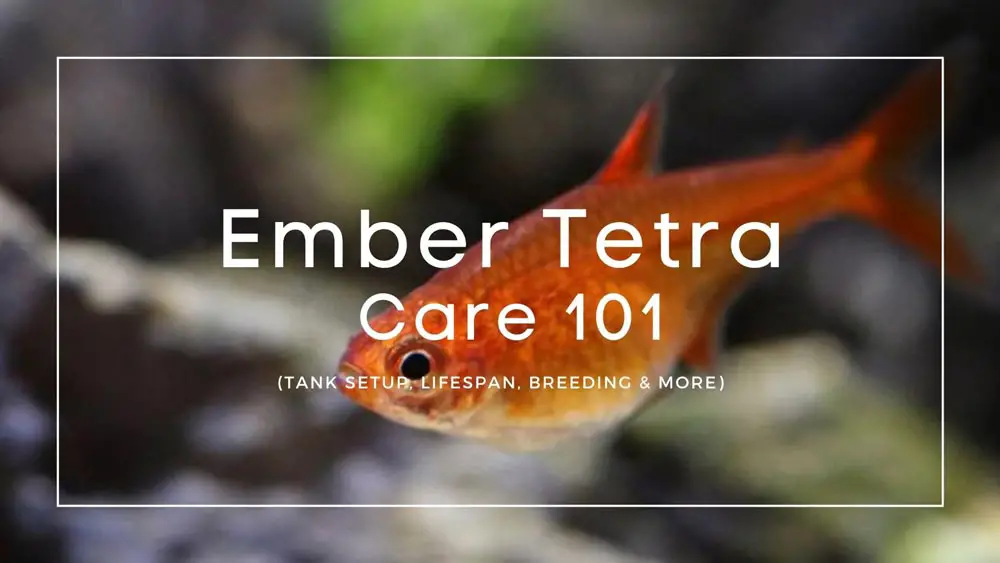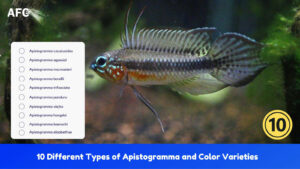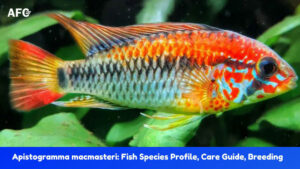If you are looking for vibrant, colorful fish to add to your community tank, then the Ember Tetra is perfect. With their fiery coloring and playful behavior, it’s no wonder this tropical fish is so popular among the aquarium hobbyists. They are a relatively inexpensive fish as well, only costing about $1 to $2 per fish.
The Ember Tetras are a schooling fish. You will want to have at least eight Embers in your tank to encourage them to school together. The more Embers you have in your tank, the larger and more brilliant and beautiful their school will be as they dart around playfully in your tank.
These fish are relatively easy to take care of and are perfect for beginner aquarists. They get along with all fish and are the ideal addition to your community tank, although you will want to protect them by not keeping larger and aggressive fish in the same tank as them. Larger fish and aggressive fish could bully them, causing undue stress to your Ember Tetras, or the larger fish could actually eat your small Ember Tetras, which would be tragic.
Species Profile Overview (lifespan, size, etc.)
The Ember Tetra was first discovered in 1986 by a man named Heiko Bleher in the South American Araguaia River basin. He named the tiny, tropical, freshwater fish Hyphessobrycon Amandae, or the Amanda Tetra, after his mother, Amanda Bleher. It is now most commonly called the Ember Tetra, Red Tetra, Fire Tetra, and Dwarf Red Tetra. The names stemmed from the fish’s vibrant and fiery appearance.
The Ember Tetra fish belong to a genuinely diverse species called Characiformes, which has about 2,000 fish spread out amongst 19 families.
Because of its playful nature and vibrant coloring, the Ember Tetra has become very trendy in the past couple of years with more than just the nano aquariums. They are a popular choice for all sizes of aquariums. But don’t let its fiery appearance fool you. The Ember Tetra is a peaceful and easy-going fish. Perfect for both the beginner and experienced aquarium hobbyists.
Within their natural habitats of densely vegetated, forested areas and slow-moving water, these fish have been known to live up to three years. You can enjoy them for the same amount of time if you care for them properly and keep them in a densely planted, well-kept aquarium.
Their lifespan is an added attraction for beginner aquarists, as well. They are a relatively short term commitment at two to three years, as opposed to some fish that live for five to ten years.
Behavior
The Ember Tetra is a schooling fish, so you need to keep them in groups of at least 5, but preferably many more. They make a beautifully vibrant school, and the more you have, the more striking the school is darting and dancing around your tank. Watching them is truly a treat, and they add so much character to your tank, you’ll be glad you got them.
Although the Ember Tetras are a peaceful fish, they are also quite active. Despite their small size, they are not a timid fish. With one exception – when they have just been introduced to a new tank, you’ll notice that they can be a bit cautious until they become used to their new tank environment. But once they have become acclimated to their new tank, you will see their frisky, playful nature come out as they swim around your tank in schools, darting in and out of the plants, and decorations.
These are very non-aggressive fish who don’t compete with the other fish either. They are a perfect addition to any community tank with their peaceful, non-aggressive, and playful behavior as they school together and interact with the other fish in their tank.
Appearance
The Ember Tetra is one of the smaller fish of their species. A completely grown adult fish can grow up to 0.8 inches long. Both the females and males look alike, so it can be challenging when you are trying to distinguish between them. Both are a fiery red color, sometimes with a saturated orange gradient coloring. Their eyes will sometimes have an orange rim around them as well.
They have an elongated, semi-transparent body. Their bodies have a large caudal fin and a somewhat small dorsal fin. Both of these fins have a little bit of a black or grey gradient. They only have one merged anal fin.
Around the upper part of their heads, around the mouth and above the eyes, they can have a reddish coloring sometimes. Towards the back of their bodies, they look slightly compressed, but this actually allows them to swim around more smoothly. They do have scales, which are very compact, lying next to each other. This is what gives them a slightly transparent appearance.
There are small differences in the females that, if you know what you are looking for, you can identify. The female Ember Tetras usually have a larger air bladder than the male. Also, during the breeding period, the female’s abdomen will get a little bigger than the male’s abdomen.
The male’s coloring will get much brighter when the females start spawning, as well. When you notice these changes in the females and males, you can transfer them to a breeding tank for spawning.
Diet and Feeding
The Ember Tetra’s feeding habits will directly affect their color and appearance. In its natural habitat, the Ember Tetra’s diet consists mainly of various zooplankton and small invertebrates. Occasionally you will see them grazing on the plants and vegetation, scraping off microbe colonies that live on the vegetation.
When you begin planning their diet, you want to create as diverse a menu as possible. You will want to include dry food such as granules or flakes, as well as frozen or live foods. You can feed them Grindal worms, Daphnia, or Artemia.
You should also take into account their size when planning their diet. Because Ember Tetras are so small, you might need to grind up their food. You can feed them small portions either two or three times daily. For the fry, you will need to grind the food into even smaller pieces for them to be able to eat it. It’s also a great idea to add plants to their tank that they can naturally graze on for an added vegetation supplement.
As long as you take care of your Ember Tetras and feed them a suitably diverse diet, they won’t need any other supplementations than what you are already feeding them.
Tank Setup
The Ember Tetra is one of the smallest fish in its species that are kept in tanks. They have become very popular with the nano aquarists, and are perfect for a 10-gallon tank.
A good rule of thumb to avoid overstocking your tank is to make sure you only have roughly one inch of fish per gallon of water. For example, the Ember Tetra is approximately 0.8 inches. If you were to have just Ember Tetras in your 10-gallon tank, you could have a maximum of 12 Ember Tetras in your tank.
In its natural habitat, the Ember Tetra comes from slow-moving waters that have dense water plants, as well as the thick vegetation that grows in the forest above the waters. All of the plants above and in the water tend to block the sunlight, which causes the lighting to be dim. With all the trees and vegetation surrounding their environment, the floor of their habitat is usually covered with branches and leaf debris.
For happy Ember Tetras, you want to mimic those characteristics in their tank. Floating plants are ideal for your aquarium, giving your fish plenty of shadowy places to hide amongst the plants and roots. Anacharis, Java fern, and Java moss will help your Ember Tetras feel right at home. These plants can also serve as shelter, breeding grounds, and food.
Putting down a dark substrate will help to mimic the dim lighting from their natural habitat. You can also put vegetation and other dry leaves along the bottom of the tank to recreate the conditions of a natural river bed. This will help to dim the lighting as well, and the decomposing leaves will leave behind some beneficial bacteria in your tank.
To duplicate the slow-moving waters that they prefer, you will want a water filtration system that is gentle, not too strong. Remember, they are used to slow-moving rivers and lakes.
Tank Conditions
As mentioned above, the Ember Tetras are freshwater fish that favor smaller rivers that have slow-flowing water. In order to recreate the water conditions, make sure the pH is within the 5.5 to 7 range, the water hardness should be around 18 dH, and the water temperature should stay within the 68 to 82°F range.
Because they are usually located in slow-moving tributaries, far away from the main streams, you want to use a silent aeration and filtrations system that is slow-moving, as well. A regular sponge filter will work quite well for the Ember Tetra’s tank.
Unless you are going with a 5-gallon nano tank, your ideal tank should be at least 10-gallons. Everyone loves plants, vegetation, and decor in their tank, but make sure that you don’t go overboard with them. You want to remember moderation is the key. You want plenty of things for them to hide in and feel safe and secure, but you don’t want to overcrowd the space they swim around in. They may be small, but they are definitely active fish that love to school together and dart around the tank.
How To Care For
Despite their small size, they tend to be healthy and are not particularly prone to diseases. However, similar to other freshwater fish, the Ember Tetra is sensitive to fluctuations in the water acidity and temperature, as well as changes in lighting.
With small fish, you always need to be careful not to overfeed them because it could cause them digestive system problems. The quality of the food you feed your fish can affect their health, as well. Keep an eye on their behavior, and if they start acting strange or lethargic, re-evaluate their food, and possibly consider buying a higher quality of food.
Another consideration for keeping them happy and healthy is regular water renewal. Having consistent water aeration and filtration is also essential to good health.
Your aquarium will require constant attention and upkeep because of all the dense vegetation and plants that you put in there. If you do not keep up with the regular cleaning, water renewal, and filtration, you will end up with a tank full of bacteria and algae.
As well as being ugly to look at, excessive amounts of algae could harm your fish. You also want to make sure that parasites are not added to your tank via other fish, or live or frozen foods. Parasitic diseases can cause their bodies to bloat and sometimes even get creamy dots on their scales and skin. Another indication of the presence of the parasite is dysfunctional shoaling behavior.
Ember Tetra Tank Mates
Ember Tetras make the perfect community fish because of their friendly and peaceful natures. They are non-aggressive and rarely cause any problems among the other fish. Because they spend most of their time in the middle of the water column, they don’t usually pick food off the floor of the tank, making pygmy catfish the perfect tankmate.
Small Corydoras and other fish from the Characidae family with similar temperaments and size are also perfect tankmates for the Ember Tetra. Other kinds of fish that compliment them are fish that swim in a different layer of the water column, such as Neons, Micro Rasboras, Rasboras, Dwarf Cichlids, and Hatchetfish. Other compatible fish include Dwarf Gourami, Discus, Barbs, and Red Cherry Shrimp.
Avoid bigger fish, especially predatory ones. A lot of the larger fish will eat anything that is small enough to fit inside their mouth, even if they are non-aggressive fish. And of course, you do not want to put aggressive fish in the tank with your Ember Tetras. They might bully your fish, compete for food, attack, and possibly kill your fish.
The same goes for non-fish tankmates. For example, most snails and shrimp get along well with the Ember Tetras, as long as they don’t start destroying your plants.
Keeping Ember Tetra Together
Ember Tetras are a schooling fish, so the more, the merrier. It’s recommended that you have at least eight in your tank so they can school together. The more you have, the more comfortable they will feel in your tank, which will decrease any possible stress significantly.
Breeding
It’s not that difficult to breed Ember Tetras. They are actually free spawners, meaning the parents don’t care for their fry.
Spawning can occur regularly without any required intervention under well-monitored conditions. But if you want to increase the number of fry that are spawned, you should control this process. In order to do this, you will need a small breeding tank. Use should use water from your main tank to optimize the acclimation process for the parent fish.
The females will get bigger when they have eggs, and the male’s coloring will get even brighter and stand out even more in order to attract females. You will want to put the fatter females that are carrying eggs into the breeding tank and place the brightest, most vibrant males in the breeding tank with the females.
If you want to encourage spawning, the lighting should be dim, and the water needs to be gently filtered. Set the water’s pH level to neutral and keep the water temperature between 80-82°F.
You should also consider upping their diet to live foods for two weeks before you want spawning to occur. Once the female has spawned her eggs, it usually takes approximately 36 hours for the eggs to incubate and hatch. Once they hatch, it will be 3 – 4 days before the juveniles start swimming around the tank.
Once the fry have hatched, you will want to either remove the parent fish from the tank or place a breeding mesh along the base of the tank to separate them from the fry. This will keep the parent fish from eating the fry. Remember, fish will eat anything that is smaller than itself.
As for feeding the fry, since they are so small, you may need to grind the food into smaller pieces than you normally would for the adults.
Conclusion
Although they are super easy to take care of, you do want to take into consideration their small size and their sensitivity to certain water conditions.
In order to keep your Ember Tetras safe, remember to avoid larger fish and aggressive fish. With their peaceful natures, these fish will fit perfectly into almost any kind of aquarium. They even do well in a nano tank of around 10-gallons.





